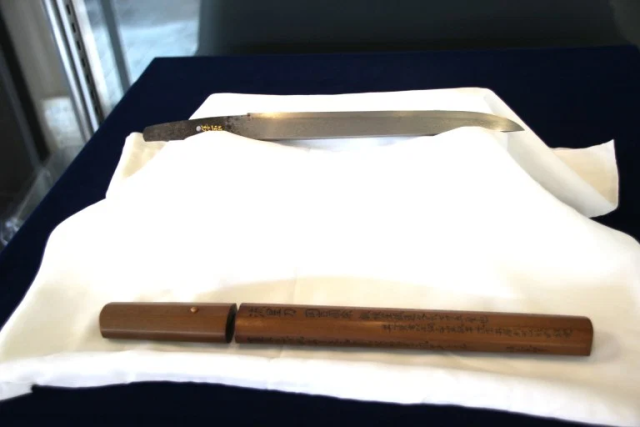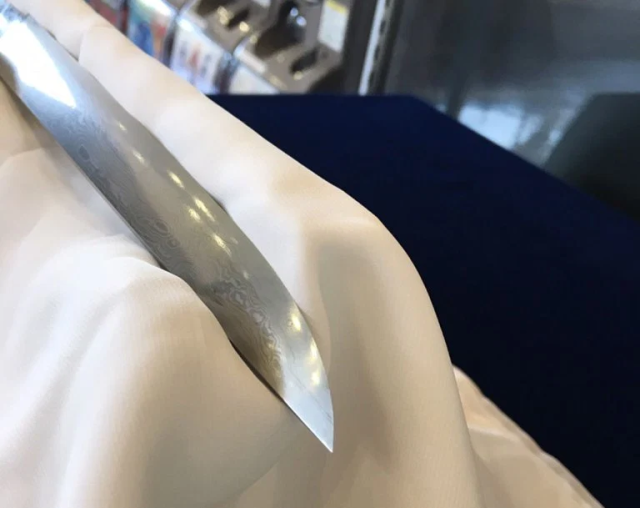Roughly 130 years ago, a farmer in what’s now Toyama Prefecture was digging for potatoes when he came across an unusual stone. Even appraisers from the Osaka mint couldn’t tell what it was, and it spent the next several years being used as a tsukemono ishi, basically a large stone placed on top of vegetables as part of the pickling process.
However, this mysterious mineral was destined for greater things. In 1895, geologists from the Ministry of Agriculture and Commerce determined that the stone was a meteorite, which they would dub the Shirahagi Meteorite (Birch Meteorite). It was purchased by Enomoto Takeaki, a samurai who would go on to play a key role in the creation of Japan’s first modern navy and also serve as Minister of Communications, Education, Foreign Affairs, as well as two separate terms as Minister of Agriculture and Commerce.
Instead of using the meteorite to make some pickles, Enomoto decided to use it to make some swords. Enlisting the services of swordsmith Okayoshi Kunimune, Enomoto commissioned five blades, two long swords and three tanto (literally “short swords,” but often closer in length to daggers) to be forged from the Shirahagi Meteorite. One of the tanto is housed at the Toyama Science Museum in Toyama City, and we took a trip to see its celestial craftsmanship for ourselves.
Of the five meteorite blades, collectively known as the Ryuseito (literally “comet swords”), the higher quality of the two katana was presented by Enomoto to the current crown prince of Japan, who would later become Emperor Taisho, who reigned from 1912 to 1926. The remaining four were handed down to Enomoto’s descendants. The second katana is now owned by Tokyo University of Agriculture (which grew out of an institution Enomoto founded). As for the three tanto, one is in the possession of Ryugu Shrine in Otaru, on the island of Hokkaido, one’s whereabouts are unknown, and one is the blade seen here, kept as part of the Toyama Science Museum’s collection.

The tanto isn’t on permanent display, but visitors can feast their eyes on it between now and Oct 14. On our visit, we also had the chance to talk to Mr Hayashi, the museum’s astronomy curator, who told us more about what makes the blade so special.

For starters, it’s not just the origin of the metal in the Ryuseito that makes it different. Meteoric iron has a nickel content of about 10 percent, which is higher than terrestrial iron, and also less carbon. That actually makes it somewhat difficult to work with, since a lower carbon content makes the metal comparatively resistant to hardening during quenching. Because of that, the ryuseito aren’t made from meteoric iron alone, but an alloy that’s 70 percent meteoric iron and 30 percent tamahagane, the iron sand-rich metal used for regular katana.
▼ The Ryuseito’s scabbard

In his journals, Enomoto says that the Ryuseito “cut well,” but Hayashi is somewhat skeptical of the claim. Even with their tamahagane content, the Ryuseito have less carbon than similar swords forged from occurring-on-earth components, and so while “meteorite sword” sounds like the sort of thing that should let you slay dragons and cleave ogres, it might not actually be the most combat effective blade, not that Hayashi and his colleagues have actually tried cutting anything with the priceless historical artifact which it’s doubtful anyone could repair (it took Okayoshi three years to complete the five swords).
However, there is one advantage to the use of meteoric iron, which is that it produces uniquely beautiful hamon (tempering marks) along the blade’s surface. The Ryuseito had to be forged at higher-than-normal temperatures, and the final result is stark black waves that flow over the metal.

Hayashi was also able to dispel a rumor about the Ryuseito. Some people claim that unlike most notable Japanese swords, which bear the smith’s inscribed signature on their inner hilt, the Ryuseito are unmarked. That’s not the case, though, as we can clearly see the kanji for “Kunimune” engraved into the sword, as well as a solid-gold inlay reading seitetsu, or “star iron.”

So while the Ryuseito may or may not do you much good in a duel, it’s undeniably awesome to look at, and well worth stopping by the Toyama Science Museum to see if you happen to be in the area. As for the fifth Ryuseito, we’ll just have to keep our fingers crossed that it turns up, but if a farmer can find a meteorite while looking for potatoes, hopefully someday someone will find the long-lost fifth sibling sword too.
Museum information
Toyama Science Museum / 富山市科学博物館
Address: Toyama-ken, Toyama-shi, Nishinakanomachi 1-8-31
富山県富山市西中野町1丁目8-31
Open 9 a.m.-5 p.m.
Admission 520 yen
Read more stories from SoraNews24.
-- There’s a katana in the Tokyo Skytree that’s forged from a meteorite!
-- Final Fantasy artist Yoshitaka Amano anthropomorphizes katana made from a meteorite
-- Sword of one of Japan’s last samurai discovered in house in America
© SoraNews24 Take our user survey and make your voice heard.
Take our user survey and make your voice heard.















1 Comment
Login to comment
Fox Sora Winters
I hope the fifth blade does show up again. While it's estimated that a substantial amount of space debris falls to Earth, even of what actually survives the decent tends to fall into the oceans, so it's very rare that anything gets made from meteoric metals. While a Ryuseito may not be as magical as it sounds, it certainly makes for a priceless artifact, and well worth preserving in that case. Who knows, maybe it'll turn up one day alongside the Honjo Masamune or some other famous lost Nihonto.